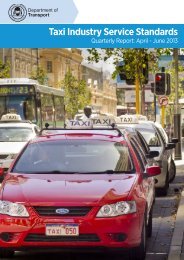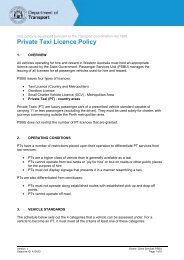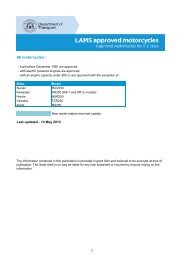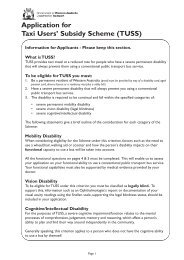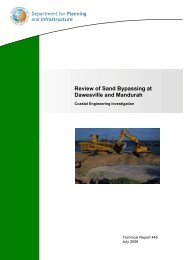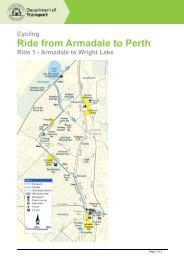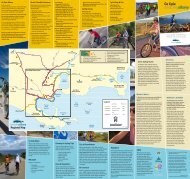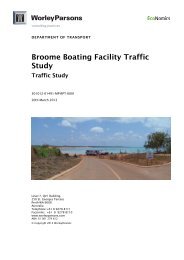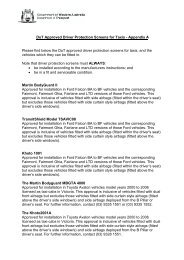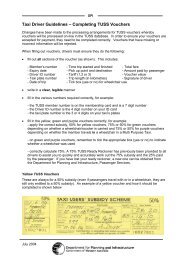Department of Transport Annual Report 2010 - 2011
Department of Transport Annual Report 2010 - 2011
Department of Transport Annual Report 2010 - 2011
You also want an ePaper? Increase the reach of your titles
YUMPU automatically turns print PDFs into web optimized ePapers that Google loves.
Rate <strong>of</strong> reported incidents (accidents) on the water per 100 commercial<br />
vessels surveyed under the Western Australian Marine Act 1982<br />
All commercial vessels in Western Australia are subject to survey to ensure they meet<br />
minimum standards for construction and equipment safety before they may begin<br />
to operate. These vessels are surveyed annually to ensure safety and maintenance<br />
standards are upheld (excluding vessels certified as Class 4 Hire and Drive vessels).<br />
Under the Western Australian Marine Act 1982 all accidents or incidents that result<br />
in serious injury or death, or cause damage to the vessel rendering it unseaworthy<br />
or unsafe, must be reported and, as mentioned above, a commercial vessel must<br />
hold a current certificate <strong>of</strong> survey to show that it meets national and international<br />
maritime standards to continue to operate.<br />
The information for this indicator is derived from the DoT’s commercial vessel<br />
database and the marine incidents database, and is calculated by dividing the<br />
number <strong>of</strong> incidents by the number <strong>of</strong> commercial vessels holding current survey<br />
certificates (expressed as a rate per hundred vessels).<br />
A reduction in the rate <strong>of</strong> incidents per commercial vessel indicates that the safety<br />
outcome is being met in relation to commercial activities.<br />
Rate <strong>of</strong><br />
reported<br />
incidents<br />
(accidents)<br />
on the water<br />
per 100<br />
commercial<br />
vessels<br />
surveyed under<br />
the Western<br />
Australian<br />
Marine Act<br />
1982.<br />
98<br />
2007-08<br />
actual<br />
2008-09<br />
actual<br />
2009-10<br />
actual<br />
<strong>2010</strong>-11<br />
target<br />
<strong>2010</strong>-11<br />
actual<br />
5.15 3.26 5.11 4.00 5.95<br />
Reasons for<br />
significant variance<br />
The introduction <strong>of</strong><br />
a penalty provision<br />
for non-reporting <strong>of</strong><br />
incidents appears to<br />
have had an impact on<br />
incident numbers known<br />
to the DoT. In turn,<br />
there has been a shift<br />
<strong>of</strong> fishing vessels now<br />
surveyed to operate as<br />
trading vessels in the<br />
North-West servicing<br />
the resource industry.<br />
Rate <strong>of</strong> reported incidents (accidents) on the water per 10,000 registered<br />
recreational vessels.<br />
Western Australia’s temperate climate and unique marine environment entice an<br />
estimated 250,000 people to make recreational use <strong>of</strong> the State’s waterways each year.<br />
DoT takes a lead role in ensuring the safety <strong>of</strong> the State’s mariners through:<br />
• setting standards for recreational vessels and registering only those that meet<br />
legislative requirements;<br />
• requiring recreational mariners to meet basic safety competencies through the<br />
Recreational Skipper’s Tickets (compulsory from 1 April, 2008);<br />
• maintaining marine charts and signs to promote safe navigation and warn <strong>of</strong><br />
hazards;<br />
• responding to oil spills and other pollutants;<br />
• maintaining navigational aids (NAVAIDS); and<br />
• educating and informing mariners on marine safety matters.<br />
Under the Navigable Waters Regulations 1958, to operate on navigable waters in<br />
Western Australia all vessels that have a motor or have the capacity to have a motor<br />
fitted must be registered. It is also a requirement under the Western Australian Marine<br />
Act 1982 for people to report any accident or incident that results in serious injury<br />
or death, or the vessel being damaged enough to make it unseaworthy or unsafe.<br />
The data for this indicator is taken from the DoT’s recreational vessel registration<br />
database and the marine incidents database, and is calculated by dividing the<br />
number <strong>of</strong> incidents by the number <strong>of</strong> registered recreational vessels (expressed as<br />
a rate per 10,000 vessels).<br />
A reduction in the rate <strong>of</strong> incidents per registered recreational vessel indicates that<br />
the safety outcome is being met in relation to recreational boating.<br />
Rate <strong>of</strong> reported<br />
incidents<br />
(accidents)<br />
on the water<br />
per 10,000<br />
registered<br />
recreational<br />
vessels.<br />
2007-08<br />
actual<br />
2008-09<br />
actual<br />
2009-10<br />
actual<br />
<strong>2010</strong>-11<br />
target<br />
<strong>2010</strong>-11<br />
actual<br />
9.05 9.46 9.51 9.00 12.52<br />
Reasons for significant<br />
variance<br />
Recreational vessel registrations<br />
have increased by 4.7 per cent<br />
whereas incident numbers<br />
have increased by 38 per cent.<br />
It appears the introduction <strong>of</strong><br />
a penalty provision for nonreporting<br />
<strong>of</strong> incidents has had a<br />
negative effect on this indicator.



